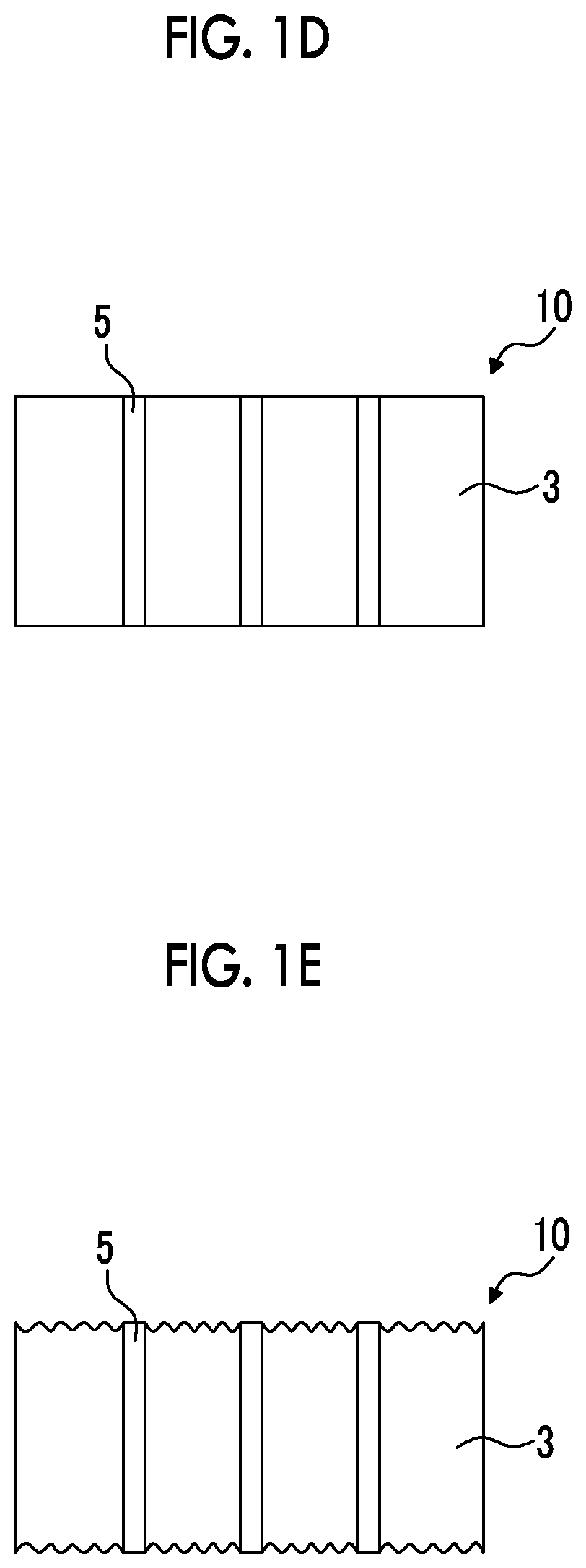Method for manufacturing aluminum plate, aluminum plate, collector for storage device, and storage device
a technology of collectors and aluminum plates, applied in the direction of electrolytic coating, electric vehicle, electrolytic manufacturing processes, etc., can solve the problems of poor adhesiveness between collectors and active material layers or undercoats, troublesome methods of mechanical drilling of aluminum plates, and poor productivity of through holes formed by etching. , to achieve the effect of excellent adhesiveness and high production efficiency
- Summary
- Abstract
- Description
- Claims
- Application Information
AI Technical Summary
Benefits of technology
Problems solved by technology
Method used
Image
Examples
example 1
[0222]
[0223]A treatment which will be described below was carried out on the surface of an aluminum substrate having a thickness of 5 m and a width of 200 mm (JIS H-4160, alloy number: 1N30-H, aluminum purity: 99.30%), thereby producing an aluminum substrate for a collector.
[0224](a1) Oxidized Film-Forming Treatment (Oxidized Film-Forming Step)
[0225]Direct-current voltage of 15 V was applied to the aluminum substrate for 16 seconds at a direct current density of 25 A / dm2 under a condition of 52° C. using a solution having an aluminum concentration of 5% or lower and the aluminum substrate as an anode at a sulfuric acid concentration of 170 g / L, thereby forming an oxidized film (the amount of the coating: 2.4 g / m2) on a single-side surface (single surface) of the aluminum substrate. After that, water washing was carried out by means of spraying.
[0226](b1) Electrolytic Dissolution Treatment (Through Hole-Forming Step)
[0227]Next, an electrolytic treatment was carried out under a condit...
examples 2 to 14
[0232]Aluminum plates were produced using the same method as in Example 1 except for the fact that the thicknesses (t) of the aluminum substrates and the quantities of electricity (Q) in the electrolytic dissolution treatment were changed to values shown in Table 2 below, and, in Example 5, an electrolytic roughening treatment described in (d1) below was carried out after the removal treatment of oxidized films described in (c1).
[0233](d1) Electrolytic Roughening Treatment
[0234]Next, an electrochemical roughening treatment was continuously carried out on the aluminum substrate that had been subjected to the removal treatment of oxidized films using 60 Hz alternating-current voltage. At this time, the electrolytic solution was an aqueous solution of 10 g / L of nitric acid (including 4.5 g / L of aluminum ions), and the temperature was 50° C. The alternating-current power source waveform was the waveform illustrated in FIG. 4, and the electrochemical roughening treatment was carried out ...
example 15
[0235]An aluminum plate was produced using the same method as in Example 1 except for the fact that a removal treatment of oxidized films described in (c2) below was carried out instead of the removal treatment of oxidized films described in (c1).
[0236](c2) Removal Treatment of Oxidized Films (Oxidized Film-Removing Step)
[0237]Next, the aluminum substrate that had been subjected to the electrolytic dissolution treatment was immersed in a sulfuric acid aqueous solution (sulfuric acid concentration: 300 g / L, liquid temperature: 60° C.) for 120 seconds, thereby dissolving and removing the oxidized film.
[0238]After that, the aluminum substrate was washed with water by means of spraying and was dried, thereby producing an aluminum plate having through holes. Meanwhile, in Table 2 below, the removal treatment of oxidized films under this condition is denoted as “acid”.
PUM
| Property | Measurement | Unit |
|---|---|---|
| diameter | aaaaa | aaaaa |
| diameter | aaaaa | aaaaa |
| opening diameter | aaaaa | aaaaa |
Abstract
Description
Claims
Application Information
 Login to View More
Login to View More - R&D
- Intellectual Property
- Life Sciences
- Materials
- Tech Scout
- Unparalleled Data Quality
- Higher Quality Content
- 60% Fewer Hallucinations
Browse by: Latest US Patents, China's latest patents, Technical Efficacy Thesaurus, Application Domain, Technology Topic, Popular Technical Reports.
© 2025 PatSnap. All rights reserved.Legal|Privacy policy|Modern Slavery Act Transparency Statement|Sitemap|About US| Contact US: help@patsnap.com



